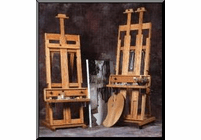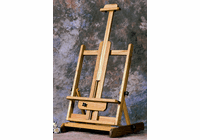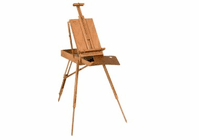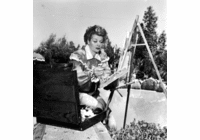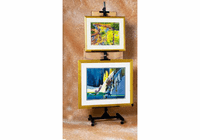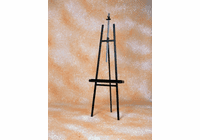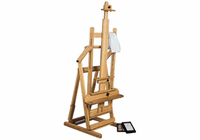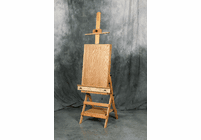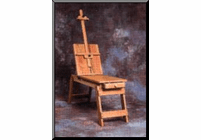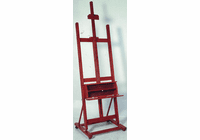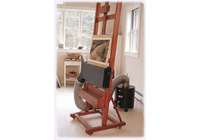EASELS
Most easels are able to hold double their weight.
(Scroll down to the bottom to read more All About Easels.)
It’s true – easel derives from the Dutch word ezel which means ass or donkey, and thanks to the reliable support easels provide, it’s not too difficult to see why they earned that moniker. Even in England today, easels are often referred to as “horses.
Easels in History (or, The Root of All Easels)
The Dutch may be responsible for our use of the modern word “easel,” but they’re certainly not the first people to have used easels in history. We have to look much farther back in history, to the Greeks or even the Egyptians, to find the roots of easels. One of the earliest depictions of an artist’s studio complete with an easel, resides in The State Hermitage Museum in St. Petersburg, Russia.
As an embellishment for a first-century Greek sarcophagus, the image shows what appear to be two canvases, one supported by an easel and one by a pedestal. Off to the side is the artist himself, (who, by the way, doesn’t look terribly happy – probably because he’s dead.) The image is especially interesting because it provides proof that easels were in common use as far back as the 1st century A.D.
In fact, literature takes the easel back a smidgen farther, thanks to a written comment made by Greek author and philosopher Pliny the Elder. Being a fairly prolific author and a fan of the arts to boot, Pliny related an anecdote about the artist known as Apelles of Kos who lived around the 4th century B.C. In this anecdote, Pliny refers to a large work of art being supported by a framework akin to what we today refer to as an easel (unless, of course, you’re Dutch, and we won’t get into that again).
Skip forward to the 12th century, and we see monks using tabletop easels to support their intricately illuminated manuscripts. And by the next century, artists were turning from the traditional mural form of painting to using canvases, which were just a wee bit more transportable than walls and ceilings, meaning art could be sold to a wider number of customers.
The use of easels during this time paved the way for artists during the Renaissance of the 14th century and later, empowering artists to create more unique and personally identifiable works of art that reflected their own unique styles. In the artist’s studio, the easel played a starring role, enabling members of the rowing upper classes to have themselves and their loved ones immortalized in oils (which, incidentally, had become the standard type of paint used by artists by the time the 16th century arrived).
Certainly, easels became critically important as artists began to explore their natural world. Easily portable, easels enabled artists to paint directly from nature, opening up a whole new world of light and color based on actual, real-time observation. Arguably, this form of plein air expression gained its greatest momentum in the 19th century with the Barbizon school and the growing interest in impressionism.
And of course today, the easel remains an important piece of equipment for artists of all skill levels. In fact, we can see easels being used as early as preschool to enable children to develop fine motor skills and express themselves, all in the fun guise of creating art.
OK, so that’s a lot about the history of easels; now to consider what to look for when selecting an easel for your own use.
Easel Selection
Easels come in a variety of styles, based in part on your own needs and the type of artwork you create. For instance, there are styles specifically designed for plein air painting, watercolor painting and pastels. Often, the easel is designed to accommodate a specific type of medium; for example, an easel designed for a watercolorist should be able to be held at an angle or even horizontally in order to prevent the paint from running while you work and as the paint dries. An easel for pastels, on the other hand, should be able to tilt slightly forward to allow and even encourage excess dust to drift away from the surface. For oils, an easel that can be held as close to the vertical plane as possible reduces the chance that dust motes will become embedded in the paint during the sometimes painfully slow drying process.
Similarly, if you intend to paint in locations other than your studio, you want to select an easel that’s lightweight enough to be easily portable, yet sturdy enough so that it doesn’t collapse in the slightest breeze if you decide to pain outdoors.
Some other characteristics to consider include:
- Stability: If you intend to use larger, wider canvases, you may prefer an easel with a flat base; however, tripod designs provide more than adequate support for many canvas sizes which makes them a more versatile choice in most cases. Of course, the level of support and stability you require will also depend on how aggressively you paint. Swift, stabbing strokes obviously require more support to avoid toppling the easel altogether.
- Material: Generally, the choice between wood and metal is one of artist preference, but there are some things to consider: Metal is easier to clean and tends to be lighter weight than comparable wooden models; wood tends to offer better support, especially for larger works, and many find their traditional looks more aesthetically pleasing.
- Adjustability: If you work with canvases or boards of various sizes, you may like the adaptability of an easel that allows you to adjust the canvas support space. These easels usually feature either an adjustable tray or adjustable clamp that slides in different directions to accommodate a range of sizes.
You should also consider your studio space. Obviously, you want an easel that’s large enough to accommodate your canvases, but not so large as to make your surroundings feel cramped and uninspiring. If your floor is uneven or slants at an angle, you may want to consider a model with adjustable legs so your easel and the canvas it’s supporting don’t rock back and forth.
Each easel offers its own unique benefits; for that reason, many artists choose to own more than one easel to ensure their varying needs and styles are supported. We offer a wide selection of high-quality easels, including studio, tabletop and French easels. We also feature easels from leading companies like SolTek and Dulce, as well as easels made of Lyptus® wood, an eco-friendly hybrid wood product that combines the benefits of two types of eucalyptus. And of course, we offer quick shipping and a lowest-price guarantee to ensure our customers can get the products they need at the best prices on the market today.
So browse our selection and take your pick from one of the web’s largest collections of top-quality easels. And feel free to amaze your friends with your new-found knowledge of easel history while you're at it.***
Artists Easels Madison Art Shop has the widest selection of fine easels from the industry’s top manufacturers including BEST, Richeson, Jullian, SolTek, Klopfenstein, and many more. Our exceptional art easel collection boasts top-quality items, many available for half off the suggested retail price. This huge array of art easels, combined with Madison Art Shop’s incredible prices, ensure that any artist can find just what they are looking for!
An easel makes a great gift, long used & long remembered!
Best Selling Easels:
The SOLTEK Easel | JULLIAN FRENCH EASEL w/ Free Carrying Bag (Backpack) | The Academy DULCE Easel
***
Art Easels are our specialty. Browse our superior collection to find studio easels, table top easels, French easels, and many more available in wood, metal, and even the highly praised Lyptus wood. Although our top sellers include the SolTek easel, the Academy Dulce easel, and the BEST Classic Dulce easel, you’ll find other easels with great features like supply drawers, trays designed to catch pastel dust and carrying cases for easy portability. We offer fast and affordable shipping options for easel and furniture orders to ensure the highest convenience for our customers.
TIPS ON EASEL SELECTION
Do I need an easel?
The choice to use an easel is completely up to the artist. Although some artists choose to work without one, many prefer the stability. Due to the wide range of models and artistic preferences, some artists even own several that specifically cater to various art forms. If you have never used an easel, it is advisable to test the waters first with an inexpensive model. Once you have an idea what features you would like, and you are comfortable using it, replace it with a higher quality easel that’ll last for years.
Some features to consider when buying an easel:
• Support: Consider the weight of your canvas and whether your easel will be capable of keeping it steady. For instance, a flat base easel offers more stability for a wide canvas, but a three-legged easel is generally more versatile for a wider variety of canvas sizes. More emphatic painters who stab at the canvas should opt for the most stable models possible, or you may run the risk of pushing or breaking the easel.
• Space: Where will you be using your easel? If you are working within the confines of limited space, you do not want to purchase a large easel. In addition, if your floor is uneven, an easel with a flat base will not function properly.
• Adjustability: This allows you to work with a variety of canvas sizes. Some easels have adjustable canvas trays to meet the artist’s line of vision. Other models have an adjustable clamp that attaches the canvas to the easel for added support. Adjustable legs are another nice feature that allows you to work from various heights.
• Portability: Do you plan to paint in different studios or outside? If you do not plan on keeping your easel in one place, consider the easel’s height and weight. You do not want to lug around a heavy, bulky easel (it might disrupt your creative mood). Some easels are even available with carrying bags for added convenience.
Wood or Metal?
This decision is entirely based on your personal preference. Easels constructed from plastic or other artificial materials exist, but they are generally avoided by artists. Most artists prefer wooden easels, because they are the most aesthetically pleasing and generally offer better support. For this reason, larger easels are generally made of wood.
Unfortunately, wooden easels are typically more expensive. Some artists prefer the modern, industrial look of aluminum easels, and other artists appreciate the light weight. They are easier to clean, more durable, and more portable than their wooden counterparts. Aluminum easels are best when used for small and medium works.
Tips for Painting on an Easel
• Watercolor: should be held at an angle or completely horizontal to prevent the paint from running.
• Pastels: often used on easels with a forward tilt option to allow excess dust to fall from the canvas.
• Oil Paintings: tilt vertically or as close to vertical as possible to avoid dust getting trapped in the paint while it dries.
• Acrylic: acrylic paint dries quickly, so you can paint at any angle that feels comfortable. Dust collection is not a concern.

